Pumpkin Cheesecake
This post may contain affiliate links. Read my full disclosure policy.
This pumpkin cheesecake is the ultimate sweet ending to your Thanksgiving feast—and no one will miss the pumpkin pie!
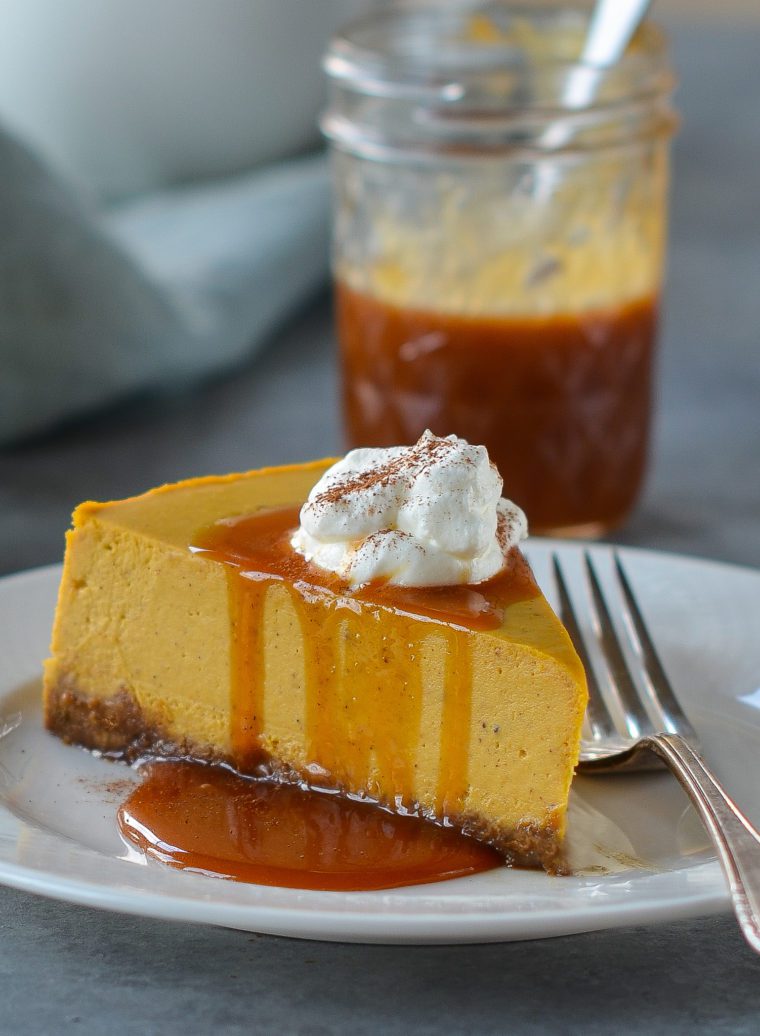
Pumpkin pie is a classic Thanksgiving dessert, but pumpkin cheesecake is just as festive and, honestly, even more delicious. This recipe combines the rich creaminess of classic cheesecake with the warm spices of pumpkin pie. Instead of the traditional graham cracker crust, I use a gingersnap crust to complement the spiced filling and bring out the pumpkin flavor. The homemade caramel sauce is optional, but absolutely worth making. Plus, it takes less than 10 minutes in the microwave!
While cheesecake might seem intimidating, it’s actually quite simple to make with only a few ingredients. The key is baking it in a water bath to ensure even cooking and prevent cracks. It might sound fussy, but it’s really not—just place the cake pan in a larger pan and fill the larger one with water. I’ll guide you through the whole process below. Let’s get started!
Table of Contents
“I love pumpkin, but not pumpkin pie. This cheesecake was the perfect answer! It was delicious and everyone enjoyed it.”
What You’ll Need to Make Pumpkin Cheesecake
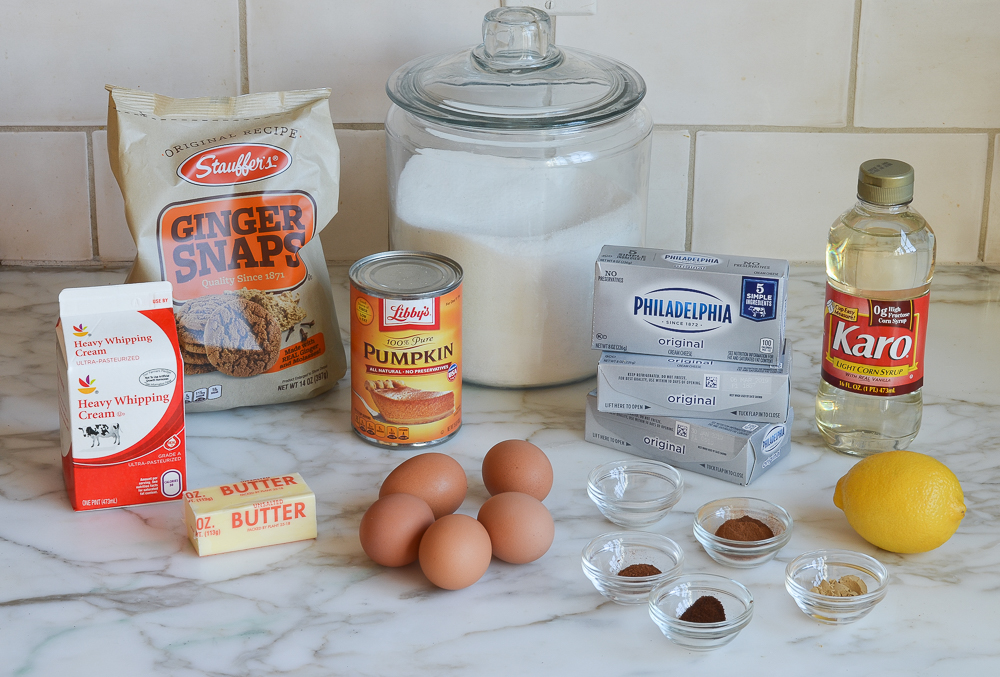
- Gingersnaps – Ground to create a spicy, flavorful base that perfectly complements the pumpkin filling.
- Melted butter – Binds the crust together and adds a rich, buttery flavor.
- Pumpkin purée – The key to the filling, providing rich pumpkin flavor and moisture.
- Granulated sugar – Sweetens both the filling and crust, balancing the spices and enhancing the overall flavor.
- Ground cinnamon, ginger, nutmeg, cloves – Classic pumpkin pie spices that add depth and complement the pumpkin flavor.
- Salt – Balances the sweetness and enhances the flavors of the filling.
- Heavy cream – Adds richness and a creamy texture to the cheesecake filling.
- Cream cheese – The smooth, creamy base of the cheesecake that gives it its signature texture.
- Large eggs – Bind the filling, helping it set while adding richness to the cheesecake.
- Caramel sauce – Drizzled on top for a sweet, indulgent finish that pairs beautifully with the warm spices and pumpkin flavor.
- Jump to the printable recipe for precise measurements
Step-by-Step Instructions
Begin by wrapping a 9-inch or 10-inch springform pan with a double layer of aluminum foil. It’s important to use heavy-duty foil because it comes in wider sheets and does a better job of preventing water from seeping into the pan. (If you’d like to try another technique that doesn’t require wrapping the pan in foil, get more guidance here.) Spray the pan with nonstick cooking spray.
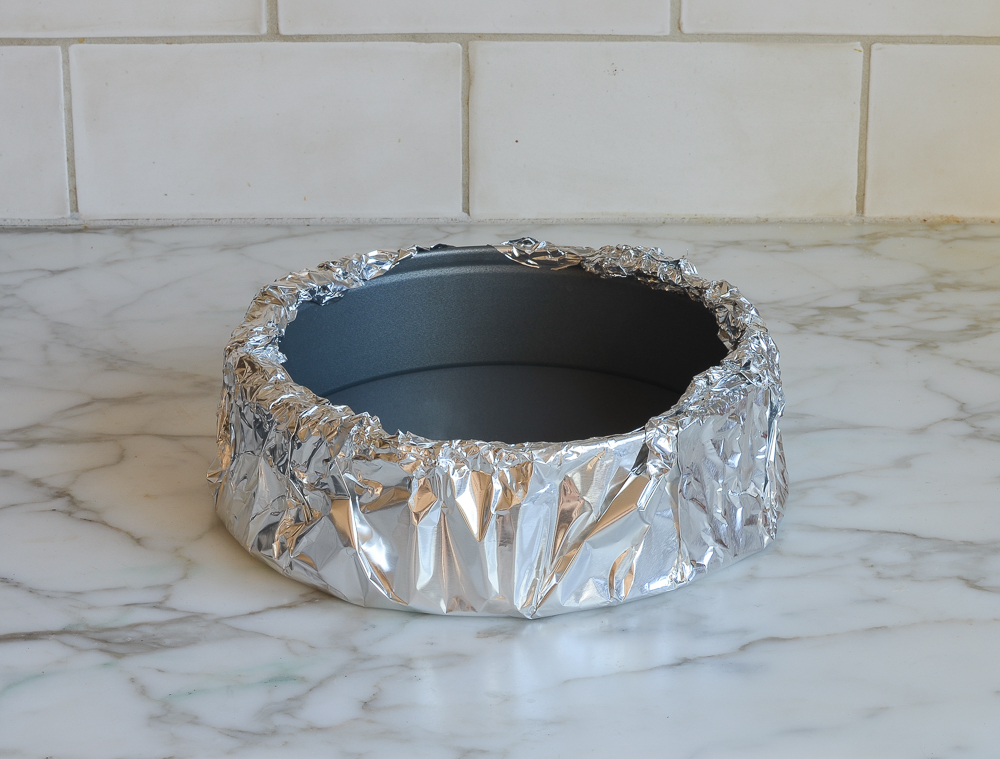
Next, make the crust: combine the gingersnap cookies, sugar, and melted butter in the bowl of a food processor.
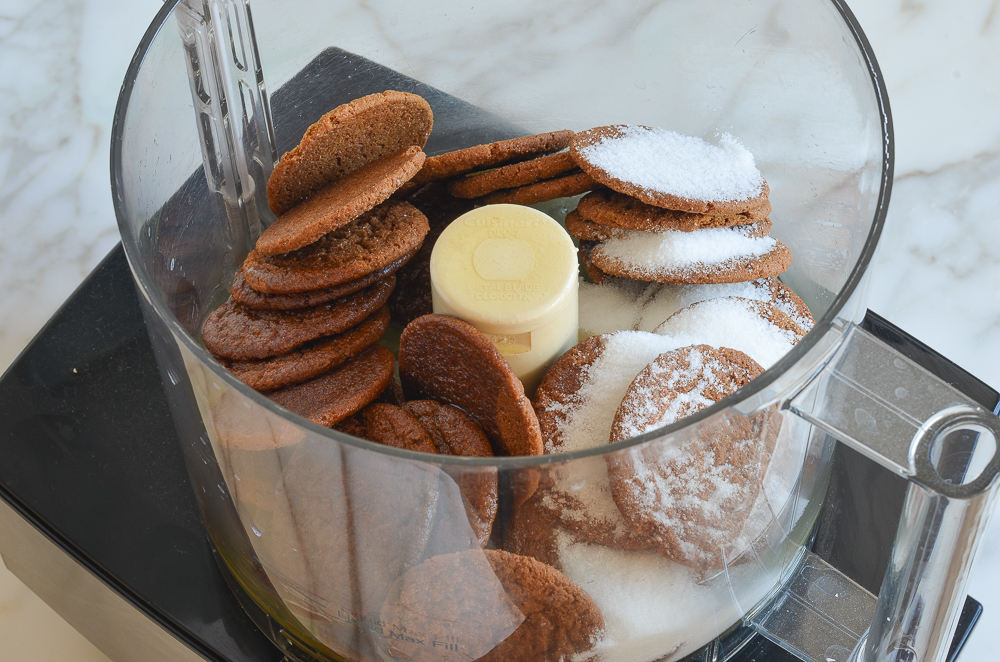
Pulse until the crumbs are fine.
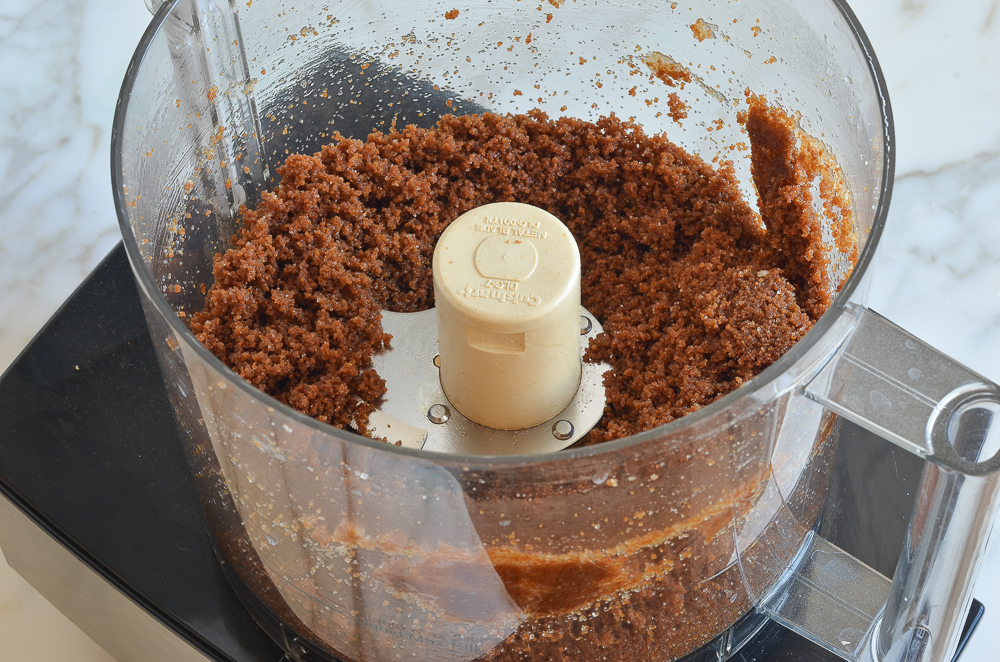
Transfer the crumbs to the prepared pan. Press the crumbs into an even layer, then bake for 15 minutes.
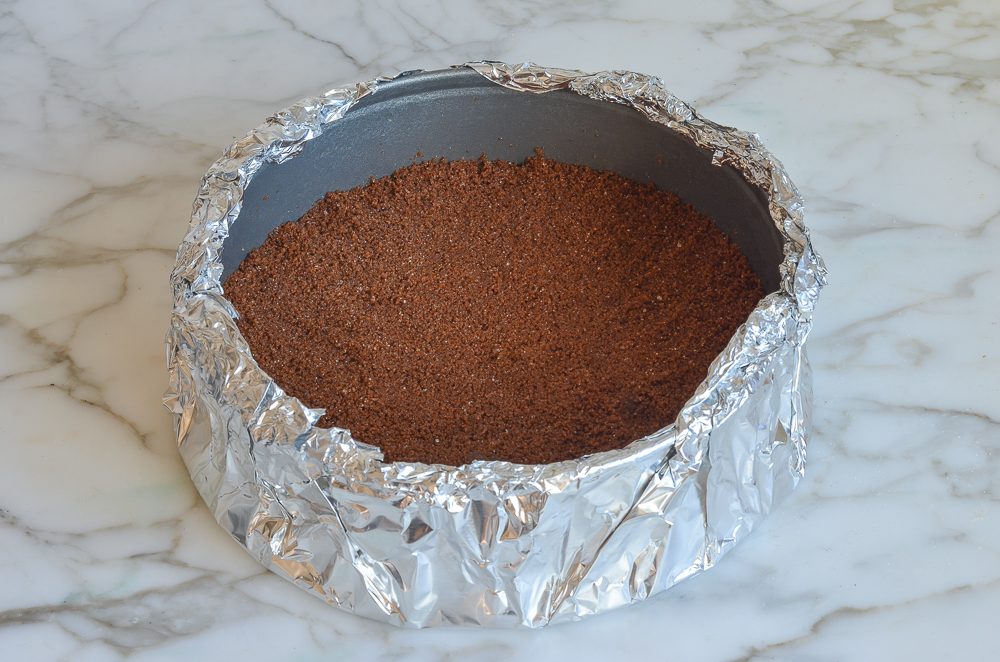
Set the crust aside to cool, and move on to the filling. Combine the pumpkin, sugar and spices in a medium saucepan.
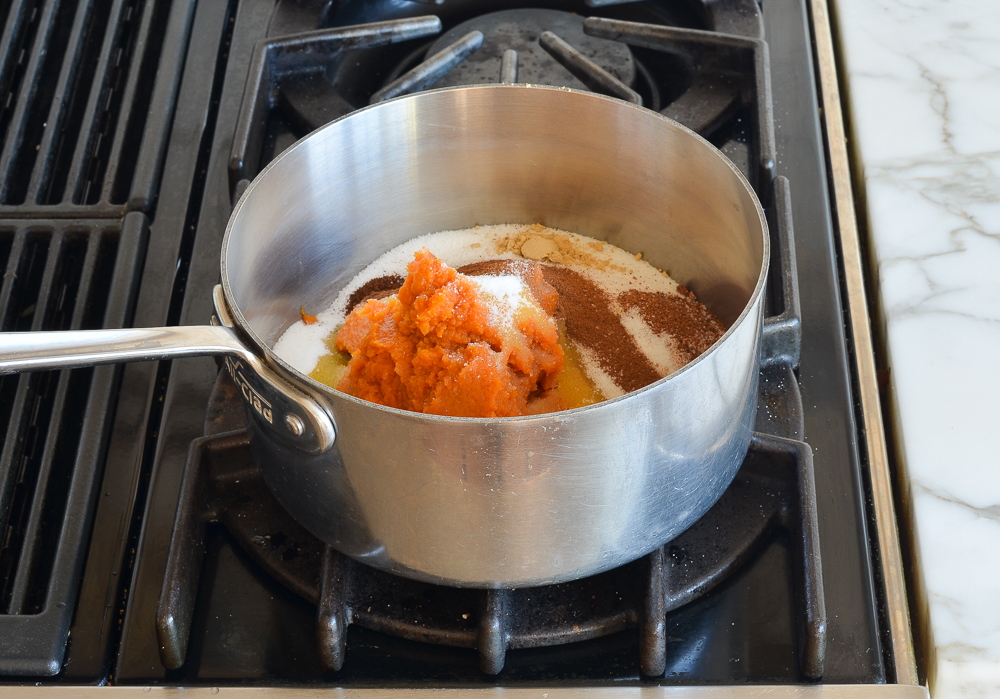
Stir over medium heat until shiny, bronze, and thickened. This step, borrowed from Rose Levy Beranbaum’s recipe, both intensifies the pumpkin flavor and dries the pumpkin out.
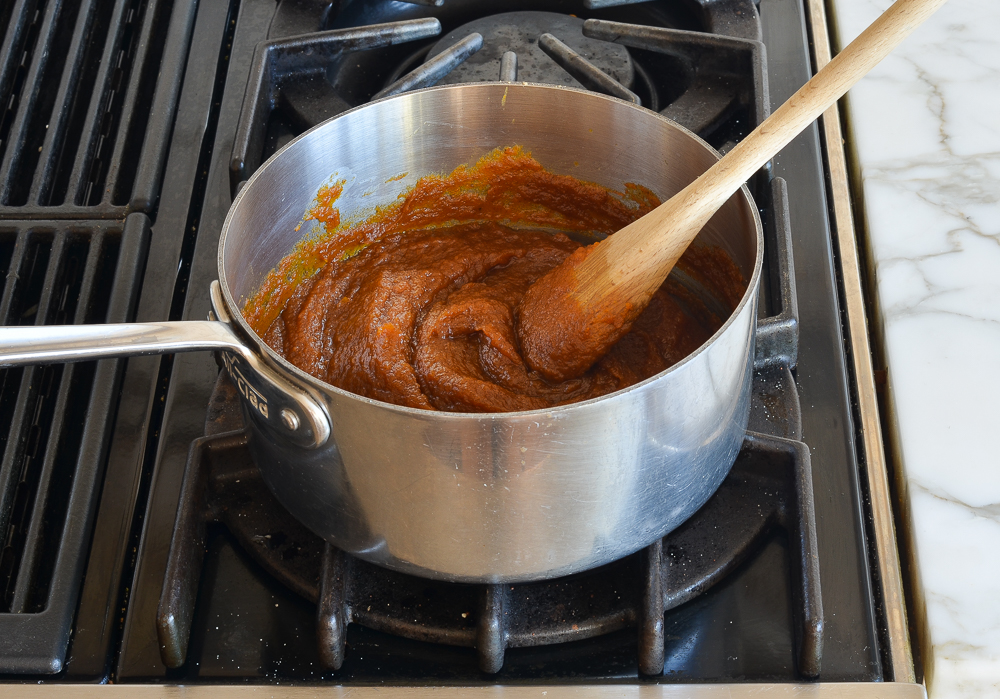
Next, transfer the pumpkin mixture to a food processor and run for one minute to smooth and cool the mixture.
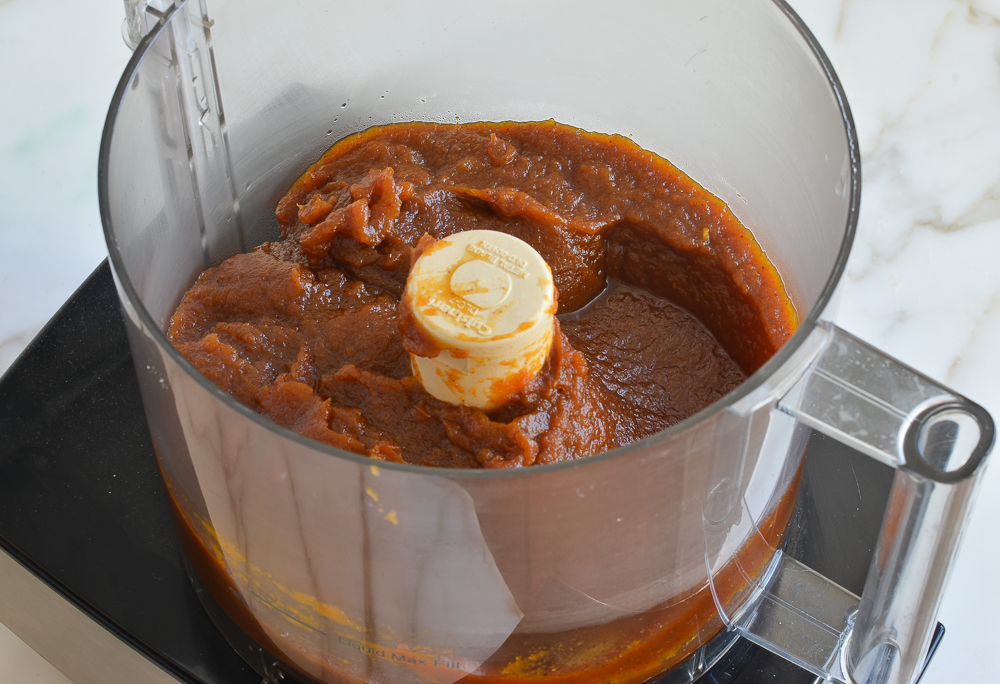
With the motor running, add the cold heavy cream. The mixture will look like this.
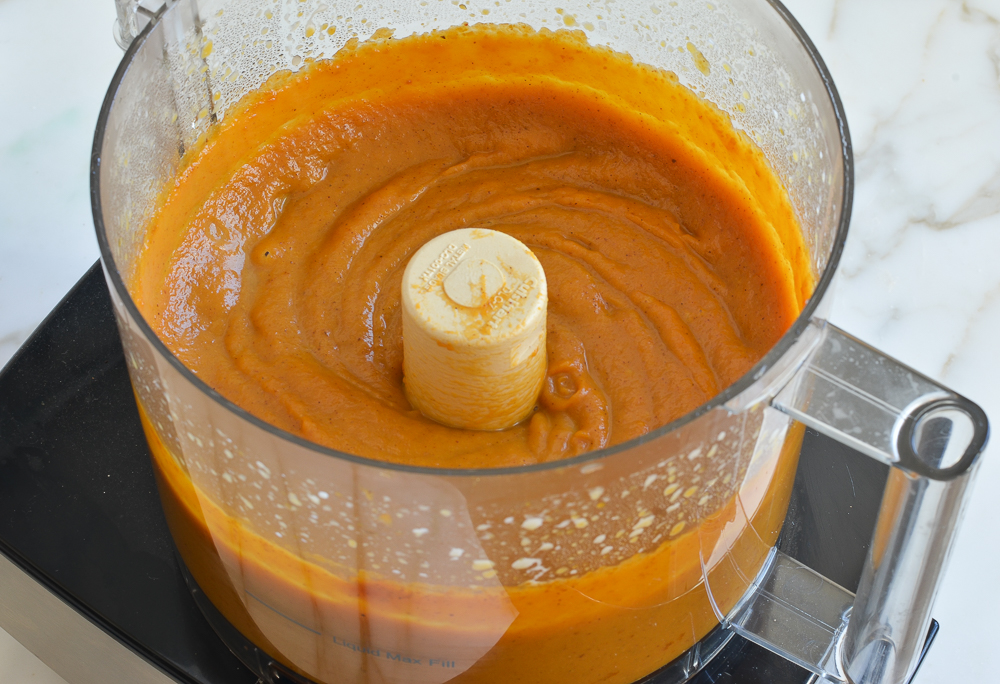
Add the cream cheese in large chunks.
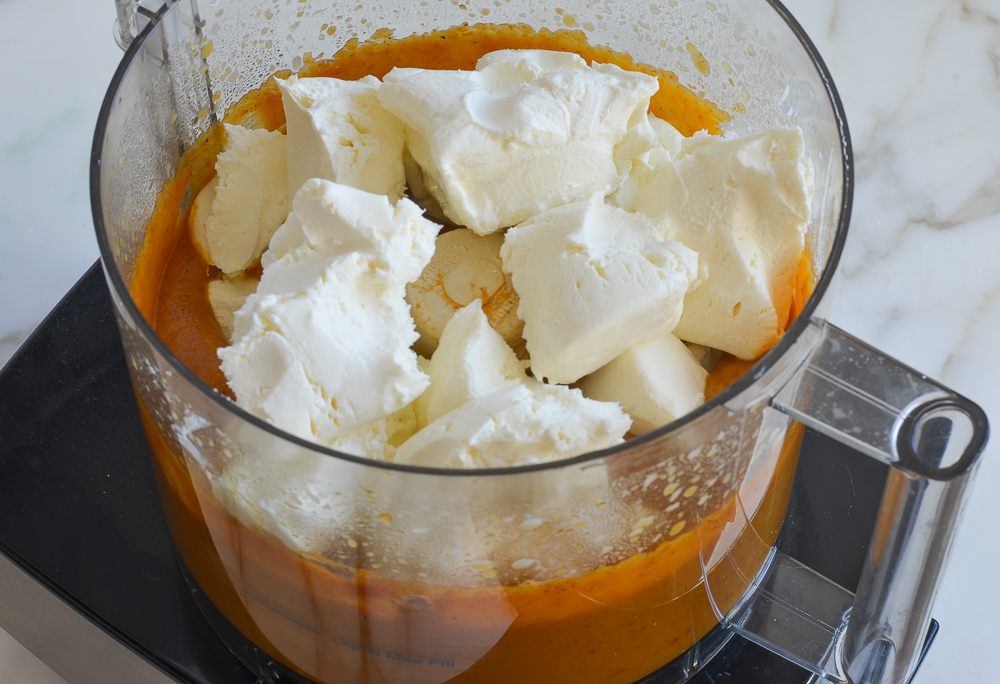
Process until the batter is smooth.
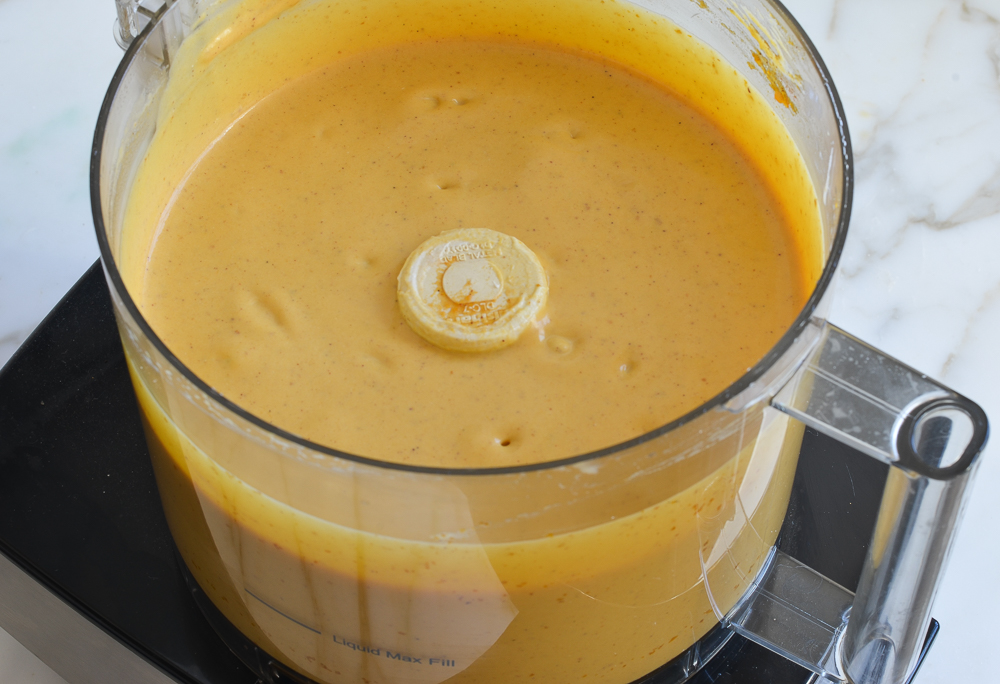
Finally, add the eggs.
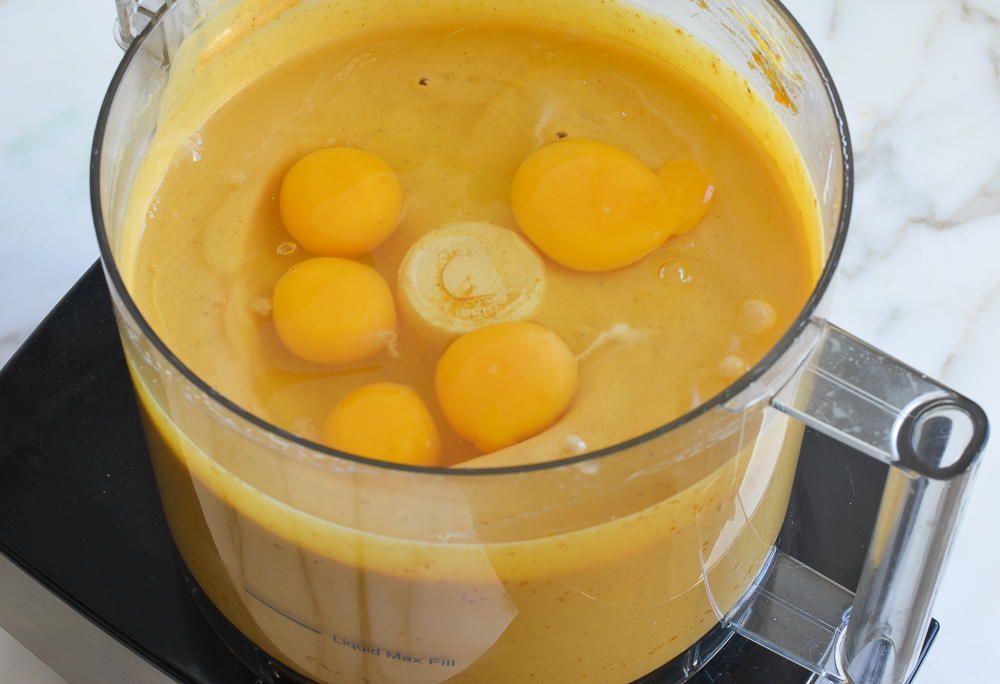
Pulse until just combined. It’s important not to over-mix — if you incorporate too much air into the filling, it will rise and crack or fall when it bakes.
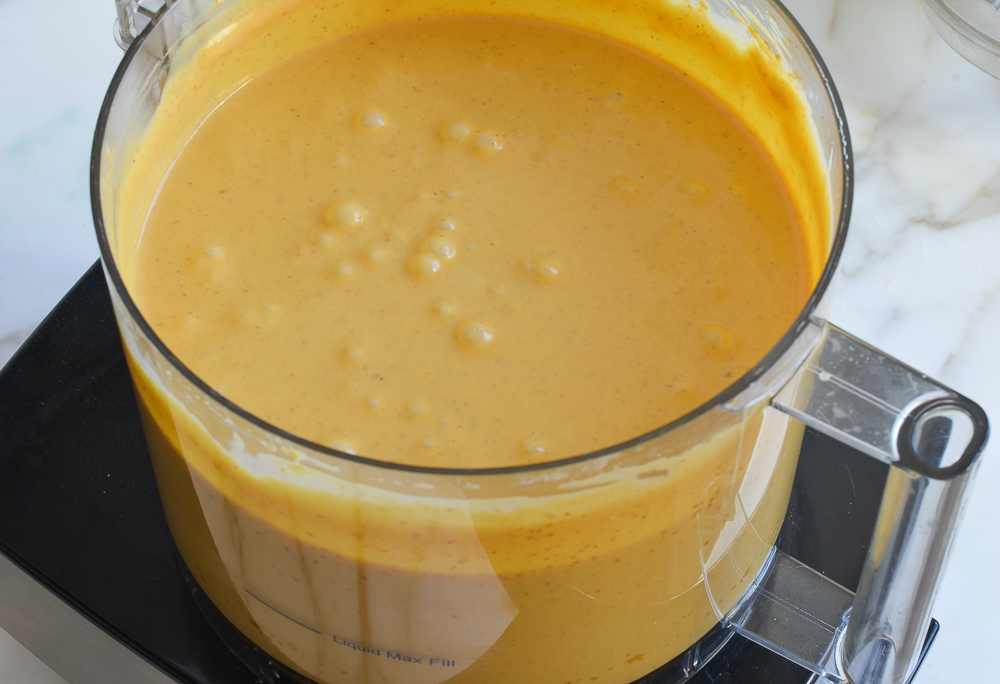
Set the cake pan in a large roasting pan, then pour the pumpkin cheesecake filling into the cooled crust.
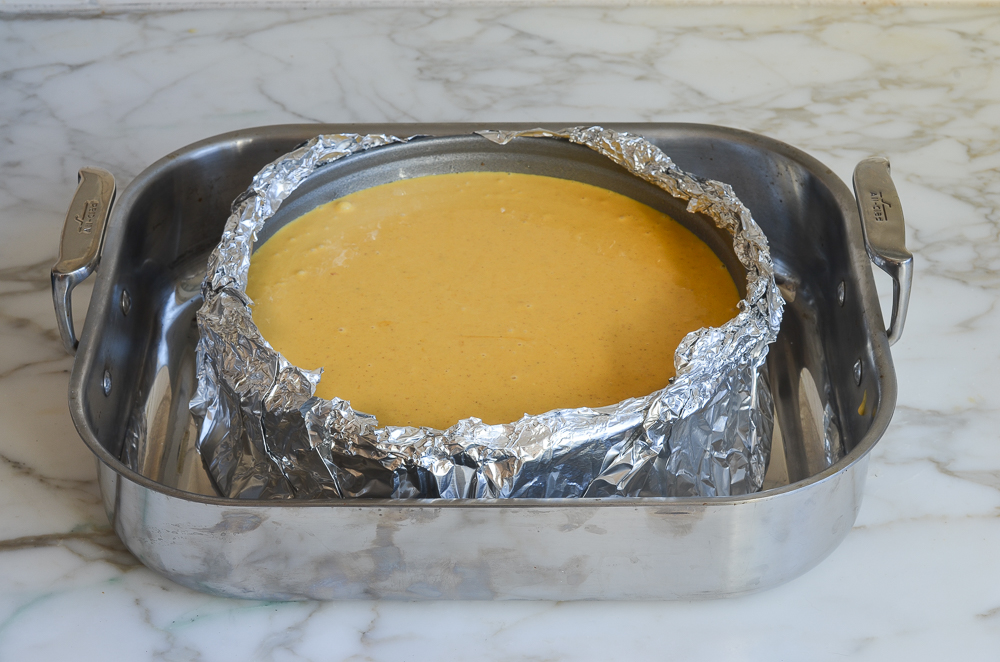
Next, pour hot water into the roasting pan until it reaches about halfway up the side of the springform pan.
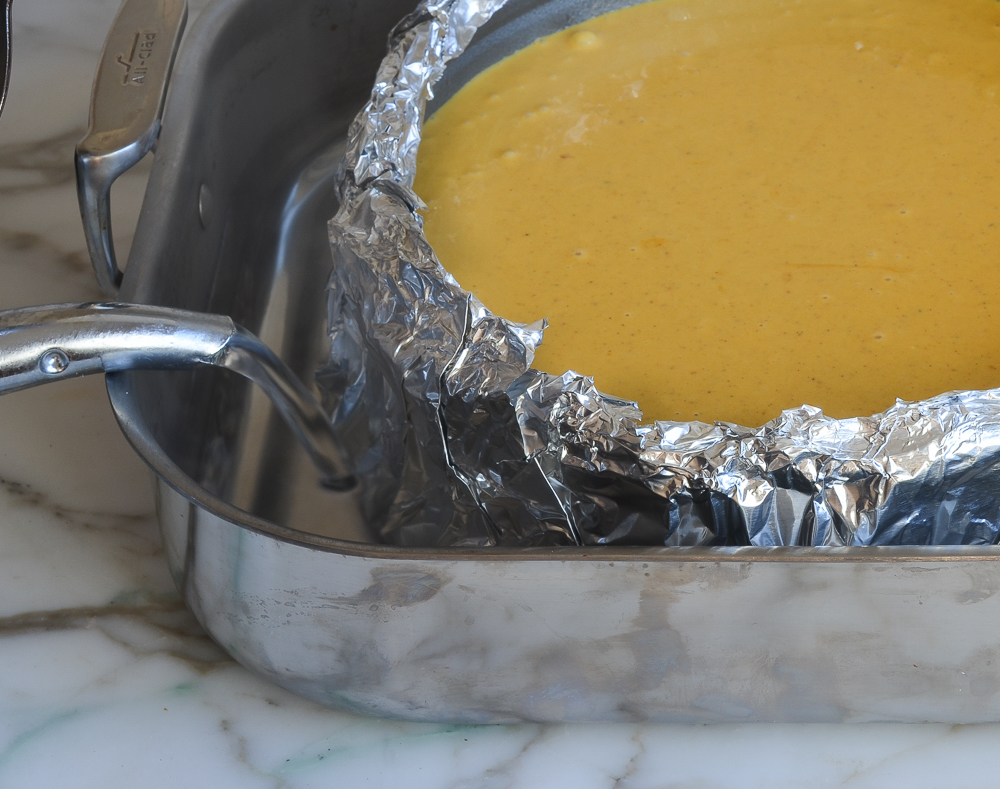
Bake in a 325°F-oven until just set, about 1-1/2 to 1-3/4 hours. A properly cooked cheesecake will jiggle a bit when you nudge the pan, but if the center still seems liquidy, it’s not done.
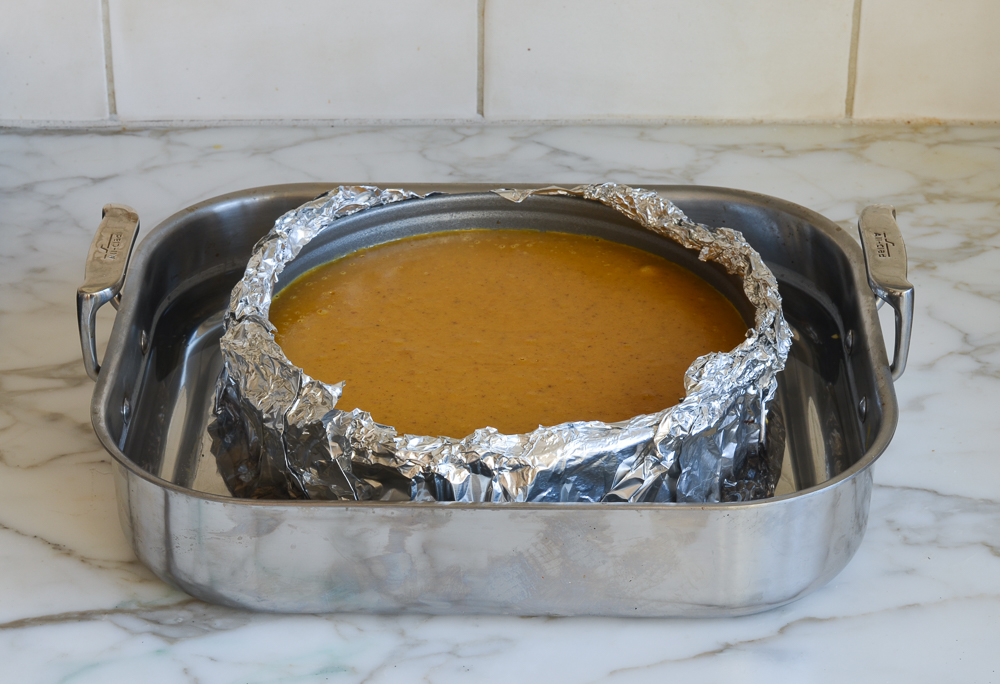
Let the cheesecake cool in the water bath, then leave it out on a rack to cool to room temperature. Finally, cover with plastic wrap and chill in the refrigerator for at least four hours or overnight. On that note, it’s a good idea to bake this pumpkin cheesecake recipe a day ahead of time or early in the morning on the day you plan to serve it.
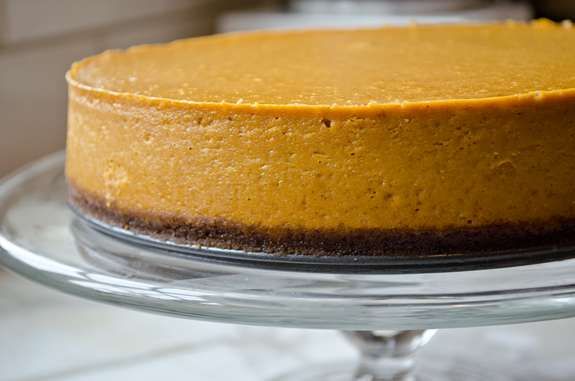
For the homemade caramel sauce—which is optional yet oh so good—I recommend a very simple recipe from Cooks Illustrated, which takes less than 10 minutes to make in the microwave and requires no fancy equipment or candy thermometers. You can see the step-by-step instructions here.
When you’re ready to serve the cheesecake, warm up the caramel sauce, drizzle it over each piece of cheesecake, and top with a dollop of sweetened whipped cream and a light dusting of cinnamon, if desired.
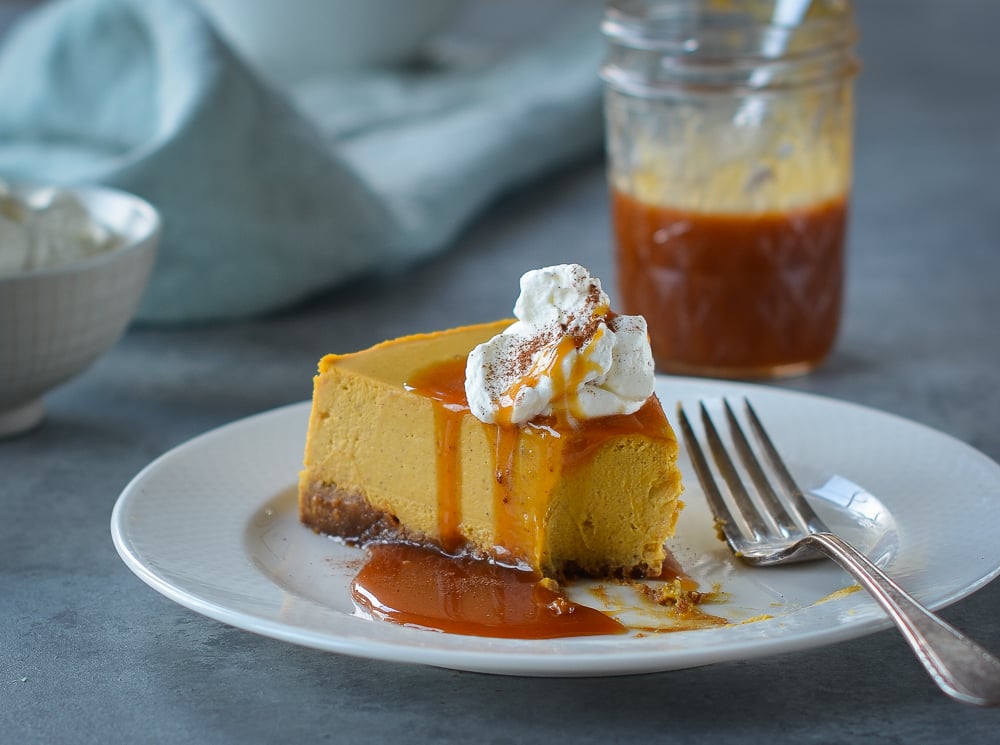
You May Also Like
Pumpkin Cheesecake
This pumpkin cheesecake is the ultimate sweet ending to your Thanksgiving feast—and no one will miss the pumpkin pie!
Ingredients
For the Crust
- 7½ ounces gingersnaps (or 1½ cups finely ground gingersnap crumbs)
- ¼ cup granulated sugar
- 4 tablespoons unsalted butter, melted
For the Filling
- 1 15-ounce can pumpkin (such as Libby's)
- 1⅓ cups granulated sugar
- 1 teaspoon ground cinnamon
- ½ teaspoon ground ginger
- ¼ teaspoon ground nutmeg
- ¼ teaspoon ground cloves
- ½ teaspoon salt
- 1 cup heavy cream, cold
- 1½ pounds (three 8-ounce packages) cream cheese, room temperature
- 5 large eggs, room temperature
- Caramel sauce, for serving
- Special equipment: 9- or 10-inch springform pan; 18-inch heavy-duty aluminum foil
Instructions
For the Crust
- Preheat the oven to 325°F degrees and set a rack in the lower middle position. Wrap a 9- or 10-inch springform pan with with one large piece of heavy-duty aluminum foil, covering the underside and extending all the way to the top so there are no seams on the bottom or sides of the pan. Repeat with another sheet of foil for insurance. Spray the inside of the pan with nonstick cooking spray. Pulse the gingersnaps, sugar, and melted butter in a food processor fitted with the metal blade until finely ground. Transfer the moistened crumbs into the prepared pan and press into an even layer. Bake until fragrant and set, about 15 minutes. Cool on a wire rack while you prepare the filling.
For the Filling
- Set a kettle of water to boil (this will be used for the water bath). In a small, heavy saucepan, stir together the pumpkin, sugar, cinnamon, ginger, nutmeg, cloves, and salt. Over medium heat, bring the mixture to a sputter, stirring constantly. Reduce the heat to medium-low and cook, stirring constantly, for 5 minutes, until thick, bronzed and shiny. Scrape the mixture into a large food processor fitted with the metal blade and process for 1 minute with the feed tube open.
- With the motor running, add the cold cream. Add the cream cheese (cut into chunks) and process for about 30 seconds, scraping the sides if necessary, or until smoothly incorporated. Add the eggs and process for about 5 seconds or just until incorporated (do not overmix!).
- Set the cake pan in a large roasting pan. Pour the batter into the cooled crust, and then pour enough boiling water into the large roasting pan to come about halfway up side of the cake pan. Bake until the cake is just set, 1½ to 1¾ hours. A properly cooked cheesecake will jiggle a bit when you nudge the pan, but if the center seems at all liquidy, it's not done. CAREFULLY remove the roasting pan from the oven and set on a wire rack. Run a sharp paring knife around the edges to loosen the cake from the sides of the pan. Cool until the water is just warm, about 45 minutes. Remove the springform pan from the water bath, discard the foil and set on a wire rack. Continue to cool at room temperature until barely warm, about 3 hours. Cover with plastic wrap and refrigerate until chilled, at least 4 hours or overnight.
For Serving
- Remove the outer ring from the springform pan. Slide a thin metal spatula between the crust and pan bottom to loosen, then slide the cheesecake onto a serving platter. (Alternatively, you can keep it on the pan bottom.) If there is condensation on the top of the cheesecake, blot it gently with a flat paper towel. Let the cheesecake stand at room temperature for about 30 minutes, then cut it into wedges. Warm up the caramel sauce in the microwave (it stiffens in the fridge). If it's too thick, add more heavy cream to thin it out. Drizzle the caramel sauce over each piece of cheesecake and top with a dollop of sweetened whipped cream if desired.
- Note: You'll need a large food processor -- preferably with a 14-cup capacity -- to make the filling (you can also use an 11-cup, but you may have a bit of leakage). If you don't have one, it's fine to use a Kitchenaid Mixer or electric beaters for the filling and a small food processor for the crust.
- Freezer-Friendly Instructions: The cheesecake can be frozen for up to 3 months. To freeze: place the cake in the freezer briefly, unwrapped, to firm it up. Then double-wrap it tightly with aluminum foil or plastic freezer wrap, or place it in heavy-duty freezer bag. Thaw in the refrigerator the night before you plan to eat it.
Nutrition Information
Powered by ![]()
- Per serving (12 servings)
- Serving size: 1 slice
- Calories: 643
- Fat: 40g
- Saturated fat: 23g
- Carbohydrates: 66g
- Sugar: 54g
- Fiber: 1g
- Protein: 8g
- Sodium: 397mg
- Cholesterol: 196mg
This website is written and produced for informational purposes only. I am not a certified nutritionist and the nutritional data on this site has not been evaluated or approved by a nutritionist or the Food and Drug Administration. Nutritional information is offered as a courtesy and should not be construed as a guarantee. The data is calculated through an online nutritional calculator, Edamam.com. Although I do my best to provide accurate nutritional information, these figures should be considered estimates only. Varying factors such as product types or brands purchased, natural fluctuations in fresh produce, and the way ingredients are processed change the effective nutritional information in any given recipe. Furthermore, different online calculators provide different results depending on their own nutrition fact sources and algorithms. To obtain the most accurate nutritional information in a given recipe, you should calculate the nutritional information with the actual ingredients used in your recipe, using your preferred nutrition calculator.

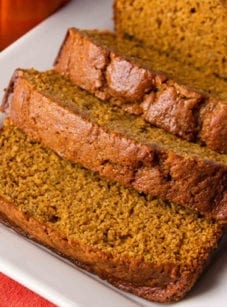
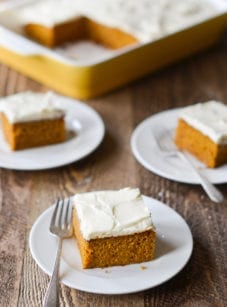
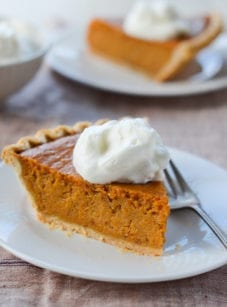
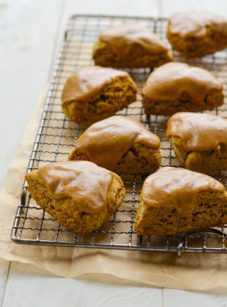
Filling is perfect–light and not overly sweet. The crust had “issues”. When I served the dessert it was very difficult to lift each slice from the springform base. The crust was compact (almost hard) and a lot of crust stayed behind stuck to the pan. I was light-handed when patting the crumbs to form the crust so that was not the cause. I did, however, experience a considerable amount of “seepage” from the filling during the baking process. When I removed the foil from my cooled cheesecake, I had to use paper toweling to “wipe off” sticky goo from the bottom of the pan. Have never experienced this before when making a cheesecake. Wondering if my pumpkin puree might have been overly moist or if it was a high butter to crumbs ratio that caused the problems.
Hi Ellie, sorry you had some problems with the crust. Depending on the gingersnap cookies you use, the butter can “seep” a little from the crust, so using a paper towel to clean that up was the right move. I’m not sure why you found the crust really hard. It can be challenging to remove from the bottom of the pan – you really need to get the spatula under there. You may want to try this graham cracker crust from my cheesecake recipe if you found this one to be challenging.
This was my very first cheesecake to make from scratch and out of all times i tried it for Thanksgiving day. Well I was really nervous but it came out very good. I got a lot of compliments all evening. This is definitely a do over and highly recommend this recipe.
Thanks for this great recipe. Just for anyone else who may be wondering, this can be done as individual cheesecake jars in a sous vide. I used the recipe without alteration, baked the crusts 10min@350F in 4oz Mason jars, added filling, then sous vide 90min@176F. Instead of the Carmel sauce, I also just made a can of dulce du leche from sweetened condensed milk. Only takes 50 min in a pressure cooker, and is done the same time as the cheesecakes.
Overall though the flavor and texture of the cheesecake was fantastic. People are still asking for more.
This was the second best cheesecake I’ve made, but almost made first place.
My caramel sauce never darkened… instead it’s the color of melted butter lol. What did I do wrong? I followed the directions, except I initially had it warmed up in a ceramic bowl instead of a glass bowl…
Sorry to hear you had a problem with the caramel sauce, Tracee! Did you let it sit for about 5 minutes after microwaving it?
I had to bake it for about 2 hours and the top of the cheesecake isn’t burnt but now has brown spots as though it is…. how did you make yours so pretty??
Hi TDS, I’m guessing you cooked it a little too long – I know it’s very hard to tell when cheesecake is done. The good news is that it won’t affect the taste. I would just swirl some whipped cream on top before serving and no one will know. 🙂
It’s Thanksgiving eve at 10:45pm and I just took the cheesecake out of the oven. I still have to wait the 45 minutes to take it out of the water bath, but after that is it okay to leave on the wire rack to cool till the morning or do I need to stay up another 3 hours? Please note to those who bake at night, this recipe is best during the daytime.
No need to stay up, Angela – I would just put it in the fridge after the initial cooling in the water bath.
Hi there – About how long should the pumpkin cheesecake take to cool in the water bath?
Hi Annetta, It should cool in the water bath for about 45 minutes.
The instructions for this recipe say to bring 4 quarts of water to boil in a kettle. First of all, 4 quarts is a gallon, so it would make more sense to advise people to choose a pot large enough to accommodate a gallon of water. Because, I would imagine, a lot of people don’t own a tea kettle with a one gallon capacity.
Thanks for catching that, Jessica – it has been corrected. 🙂
Hi Jen — HELP!! I’m in the midst of a Thanksgiving marathon, baking so many of
your delicious recipes! The bourbon pecan pie looks & smells delicious,
and the apple pie bottom crust is blind-baking. But I have 2 urgent issues:
(1) I’m considering whether to wait until tomorrow to fill the crust with your
apple mixture that I’ve already prepared & bake it then, or just go ahead and
finish baking it today & keep it out on the counter until tomorrow’s feast.
(3)Your wonderful pumpkin cheesecake which I’ve made previously has for
some reason developed a brown “skin” and cracks on the top — not too
appetizing looking. I can’t figure out what caused that, or if there’s anything
I can do about it, other than perhaps covering it up with whipped cream.
And also, most frustratingly, after double wrapping the springform pan with
large size heavy duty aluminum foil, when I removed it after cooking, I
discovered water inside!!! Such a bummer! So surely the crust will be
soggy…..These issues must obviously be caused by some error on my part —
do you have any magic tricks to fix these issues? Thanks so much for your
helpfulness!
‘
Hi Toni, I would just make the apple pie today and leave it on the countertop. It will be just as good and you can cross it off your list. It sounds like maybe the pumpkin cheesecake was cooked a little too long or at too high of a temperature (ovens can fluctuate) but that’s not a big deal. Just swirl some whipped cream on top and sprinkle with cinnamon before bringing to the table…it will look pretty and no one will know. Don’t worry about the water seeping in — I can tell you from experience that it doesn’t make that much of a difference. The crust softens a bit overnight in the fridge anyway. Hope that helps and happy Thanksgiving!